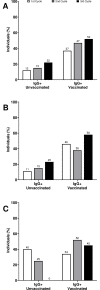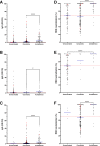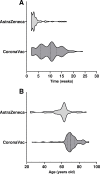COVID-19 cross-sectional study in Maricá, Brazil: The impact of vaccination coverage on viral incidence
- PMID: 36121796
- PMCID: PMC9484680
- DOI: 10.1371/journal.pone.0269011
COVID-19 cross-sectional study in Maricá, Brazil: The impact of vaccination coverage on viral incidence
Abstract
Population surveillance in COVID-19 Pandemic is crucial to follow up the pace of disease and its related immunological status. Here we present a cross-sectional study done in Maricá, a seaside town close to the city of Rio de Janeiro, Brazil. Three rounds of study sampling, enrolling a total of 1134 subjects, were performed during May to August 2021. Here we show that the number of individuals carrying detectable IgG antibodies and the neutralizing antibody (NAb) levels were greater in vaccinated groups compared to unvaccinated ones, highlighting the importance of vaccination to attain noticeable levels of populational immunity against SARS-CoV-2. Moreover, we found a decreased incidence of COVID-19 throughout the study, clearly correlated with the level of vaccinated individuals as well as the proportion of individuals with detectable levels of IgG anti-SARS-CoV-2 and NAb. The observed drop occurred even during the introduction of the Delta variant in Maricá, what suggests that the vaccination slowed down the widespread transmission of this variant. Overall, our data clearly support the use of vaccines to drop the incidence associated to SARS-CoV-2.
Conflict of interest statement
The authors have declared that no competing interests exist.
Figures





References
-
- PORTARIA No 188, DE 3 DE FEVEREIRO DE 2020—PORTARIA No 188, DE 3 DE FEVEREIRO DE 2020—DOU—Imprensa Nacional. [cited 6 Nov 2021]. Available: https://www.in.gov.br/web/dou/-/portaria-n-188-de-3-de-fevereiro-de-2020...
-
- Coronavirus disease (COVID-19) Situation Report-118.
-
- Cavalcante JR, Cardoso-Dos-Santos AC, Bremm JM, Lobo A de P, Macário EM, Oliveira WK de, et al.. COVID-19 no Brasil: evolução da epidemia até a semana epidemiológica 20 de 2020. Epidemiologia e servicos de saude: revista do Sistema Unico de Saude do Brasil. 2020;29: e2020376. doi: 10.5123/S1679-49742020000400010 - DOI - PubMed
-
- Coronavirus Pandemic (COVID-19)–the data—Statistics and Research—Our World in Data. [cited 5 Nov 2021]. Available: https://ourworldindata.org/coronavirus-data
-
- Corona Vírus—Coronavírus RJ. [cited 7 Nov 2021]. Available: https://coronavirus.saude.rj.gov.br/
MeSH terms
Substances
Supplementary concepts
LinkOut - more resources
Full Text Sources
Medical
Miscellaneous

